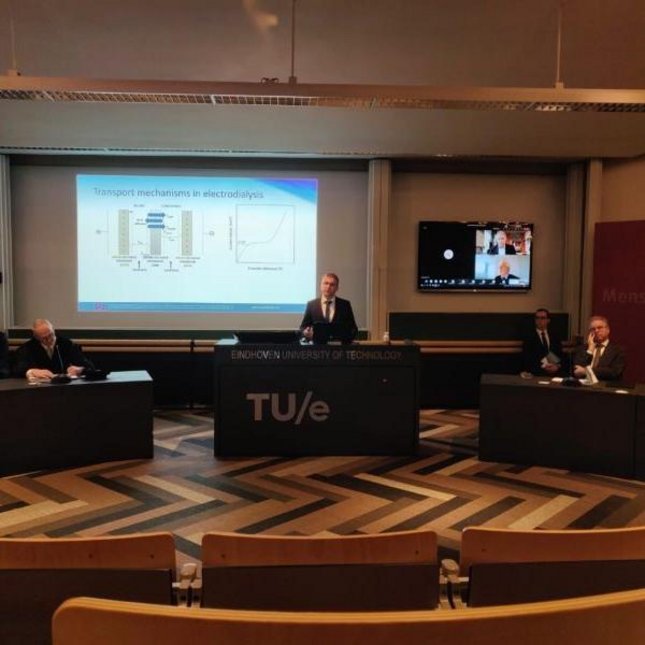MM/P PhD defense Gijs Doornbusch

Thursday 17 December 2020, Gijs Doornbusch successfully defended his PhD thesis entitled ‘Seawater desalination using multistage electrodialysis - Upscaling from artificial salt solutions to natural seawater desalination’. Gijs was employed at the TU/e and performed his experiments at Wetsus, Centre of Excellence for Sustainable Water Technology (Leeuwarden, NL).

Last Thursday 17 December 2020, Gijs Doornbusch successfully defended his PhD thesis entitled ‘Seawater desalination using multistage electrodialysis - Upscaling from artificial salt solutions to natural seawater desalination’. Gijs was employed at the TU/e and performed his experiments at Wetsus, Centre of Excellence for Sustainable Water Technology (Leeuwarden, NL).
Electrodialysis (ED) is a well-established electrochemical desalination technology. In an ED, ions migrate through respectively anion and cation selective membranes due to an applied electrical potential difference. A major advantage of ED compared to state of the art reverse osmosis for desalination, is the possibility to apply staging in which multiple stages are combined in different configurations. The benefit of this approach is that it allows localized adaptation and optimization of the desalination process parameters in each stage to the governing local conditions in that stage such that each stage can be operated at its individual optimum. This research investigates how staging in different ED configurations for seawater desalination to produce drinking water can enhance ED performance for drinking water production. For that a single stage, a multistage and an ED stack with segmented electrodes are compared.
For both single stage and multistage configurations desalination to drinking water concentration is not possible due to low applied current densities or due to limiting current density (LCD) limitations. To further improve the ED performance, a segmented electrode stack is designed. In such a configuration, one single ED stack contains multiple electrodes over the length of the stack. For a uniform current distribution, the segmented electrode stack gives a 10% lower voltage compared to the multistage configuration. Under non-uniform current distributions and constant voltage operation, the segmented electrode stack establishes higher desalination degrees (up to 8%) at low driving forces (2 V). For higher driving forces, i.e. 4 and 6 V, the segmented electrode stack suffers from concentration polarization (i.e. limiting current conditions) resulting in lower desalination degrees compared to the multistage configuration.
As a method to further increase the degree of desalination and produce drinking water in a multistage ED system, the membrane area, the residence time, and the membrane properties in the different stages were varied. The decreased flowrate in the first stages due to the higher membrane area combined with the increased flowrate (due to the lower membrane area) in the latter stages enhances the desalination performance. Due to the long residence time at the beginning of the desalination path and shorter residence times at the end of the desalination path, a 20% lower energy consumption can be obtained. Applying membranes with lower water permeation enhances the desalination performance even further. In that case, the diluate water recovery increases by 4% resulting in both a decreased diluate outlet concentration and a 15% lower energy consumption. A subsequent optimization study, combining the best results of the previous two studies, gives a state-of-the-art energy consumption of 2.2 kWh/m3for the desalination of 510 mM NaCl to 5.4 mM NaCl using multistage ED. This obtained diluate salinity more than meets the WHO standard for drinking water of 8.5 mM NaCl.
Finally, this configuration was evaluated using real natural seawater. Starting from ~27 g/l (i.e. inlet concentration of the natural seawater source), the upscaled multistage ED system produces a continuous diluate concentration of 1.9 g/l. The system performance was stable over 18 days, with an average energy consumption of 3 kWh/m3, demonstrating the potential of multistage ED seawater desalination for the production of drinking water.
For more information please contact Prof. dr. ir. Kitty Nijmeijer (d.c.nijmeijer@tue.nl) or Dr. ing. Zandrie Borneman (z.borneman@tue.nl).